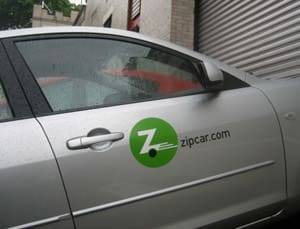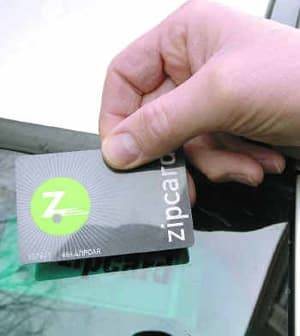A First-Hand Account of ZipCar

As car-sharing service ZipCar grows in popularity in major cities around the world, KickingTires wanted a first-hand account of what it’s like to drive a ZipCar. So began a four-hour odyssey that would take me from a downtown ZipCar location, across the city of Chicago, and back to that same ZipCar location (Michael Bay, the film rights are still available if you’re interested).
Let’s begin with the basics: What is ZipCar?
ZipCar allows city-dwellers to rent a car for a few hours without the hassle of ownership, insurance or fuel costs. It’s available in 12 American cities, and most have more than 100 remote locations — no storefronts — where you can pick up a vehicle (D.C. has more than 600 locations). Pricing varies depending on the plan you choose, but in my case I went with the Occasional Driving plan that required no money down. For a basic car — a 2007 Volvo S40 — this set me back $9.25 an hour.
With ZipCar, you have to keep in mind that pricing is based on short-term urban driving. If you want to take a road trip, you’re better off renting, as the daily rate at ZipCar can be as high as $100. Plus, if you travel more than 180 miles, the cost of fuel goes on your bill.
The concept of ZipCar makes the most sense if you need to move a couch, pick up groceries or go on a date. Once you’re a member, the reservation and check-in time is negligible as long as you can make it to a location without much hassle.
I wanted to get a good look at my vehicle, so I parked the S40 and spied it carefully from every angle. It was a pretty unremarkable car (at no point did I mistake my drive for any kind of joy ride), but I wanted a utilitarian experience, not a careening spin up and down Chicago’s Lake Shore Drive, which is what I typically like to do with our vehicles.
If you’ve ever driven a rental car, you know that dings, nicks and a deteriorating interior are always a possibility. Aside from a scuff or two, the S40 was in good shape, as were the three other cars I took a close look at in the ZipCar parking lot. The company uses its members to regulate behavior. For instance, if someone gets in a car and it reeks of cigar smoke, he or she can call a hotline and leave a message. The quality control people then look at who was in the vehicle previously and charge that person accordingly.
My favorite ZipCar feature was the card entry. Rather than handing every driver a set of keys, each vehicle is equipped with a card scanner. Once you reserve a car, you simply walk to the vehicle, swipe your card over the scanner and the doors unlock; the keys are already sitting in the ignition.

Why can’t a thief just smash the window after you park it and take off, you ask? Ingeniously, once you lock the car with your ZipCar card, the engine is disabled. The would-be robber would need your card to start the car, not just the key.
Environmentally, ZipCar makes sense. Seventy percent of its fleet consists of low-emission vehicles, and the company says each ZipCar vehicle is responsible for taking 15 cars off the road.
The ZipCar members I spoke to praised the service. Jerry Smith has used ZipCar since it opened in Chicago even though he owns a car.
“It’s not convenient to bring a car downtown, so if I need to go to a meeting out in the suburbs, I can just walk and pick it up and don’t have to worry about parking,” Smith said.
Erica VanSchaik has been using ZipCar for two years and loves not owning a car in the city.
“It’s just so easy,” she said. “I don’t have to worry about maintenance or parking tickets — I was getting a lot of those when I owned a car — or digging out of the snow.”
I have only two concerns with ZipCar. The first is that the service is tailored to a specific type of customer — one who has a steady schedule and can make reasonable plans for when he or she needs a vehicle. As a 24-year-old with all the common sense and responsibility of someone half that age (as most 24-year-old men tend to be), I cannot think of a single time when I have been able to say, “OK, I’ll need this car for two hours on Sunday.” It’s more like, “I think I’ll go to the grocery store today,” then six hours later I’m in Cincinnati. For people who cherish flexibility, even the highly un-rigid ZipCar system might seem like too much work.
VanShaick confirmed this for me.
“If I decide on the spur of the moment I need to do something or be somewhere, sometimes they don’t have cars available,” she said. “Sometimes it’s just hard to plan everything in advance.”
Smith also pointed to the rigidity of ZipCar’s late fees.
“It’s a tough late policy,” he said. “If you have the car for 15 minutes past the deadline, you have to pay for the entire hour. With traffic, that’s hard to predict.”
My other question involves how ZipCar incorporates the price of gas into the cost of its vehicles. This is a blessing, but it made me wonder how it adjusts for fluctuating gas prices. Marketing manager Tobia Ciottone told me there’s a formula for it, but that the details were not available to him.
Ciottone also said that as gas prices have climbed over the past two years, so has ZipCar’s membership. As far as ZipCar is concerned, rising gas prices are good for business. I wonder, though, in a world where a coup in Nigeria can send gas prices skyrocketing, how ZipCar as a business would respond to an oil shock.
That said, it’s clear that ZipCar has hit the transportation scene with perfect timing. It offers an effective, relatively easy way to make quick jaunts around particular cities without the hassle and worry of actually owning a car. Everywhere else, it seems you’re still better off the old-fashioned way.
Featured stories




